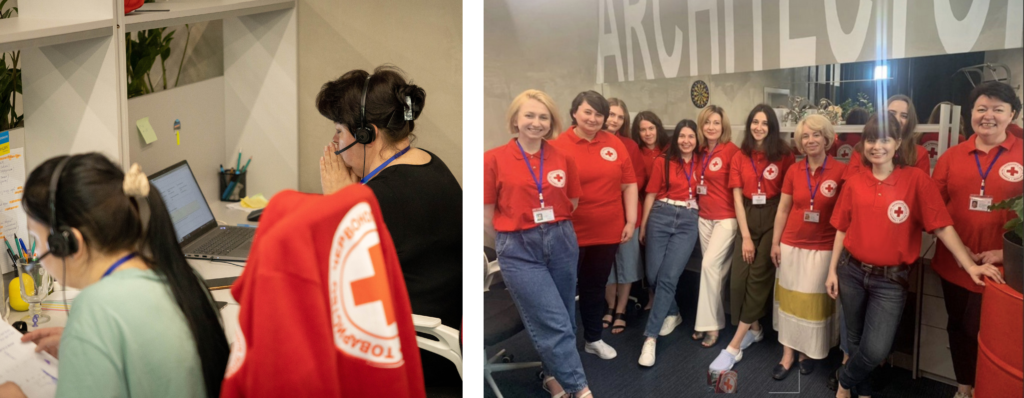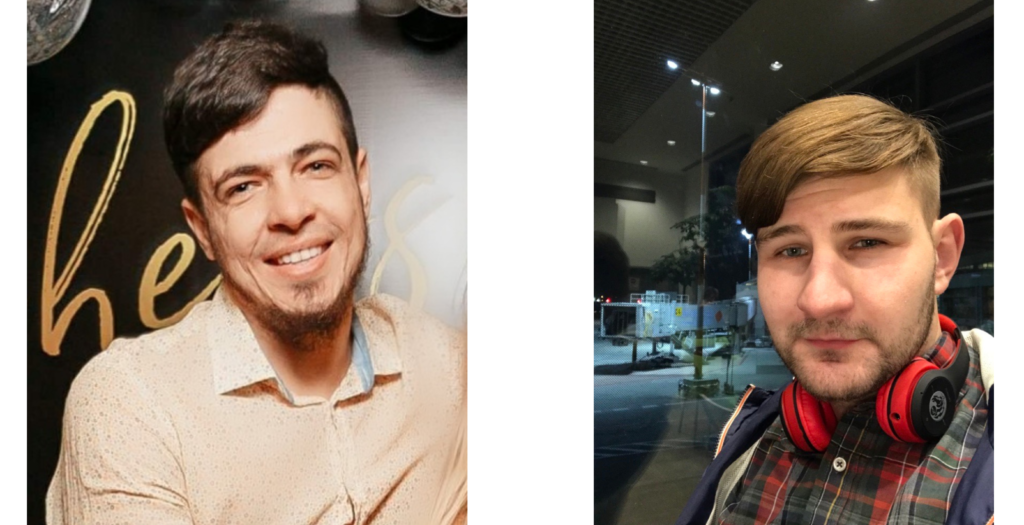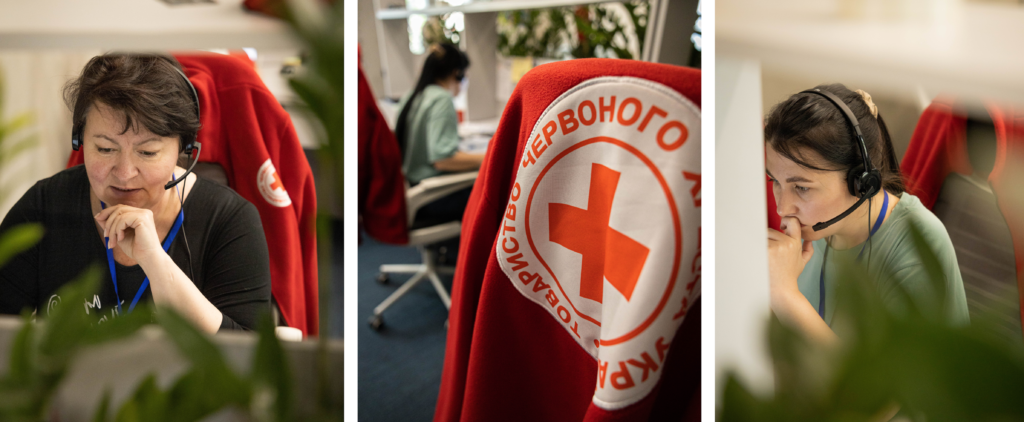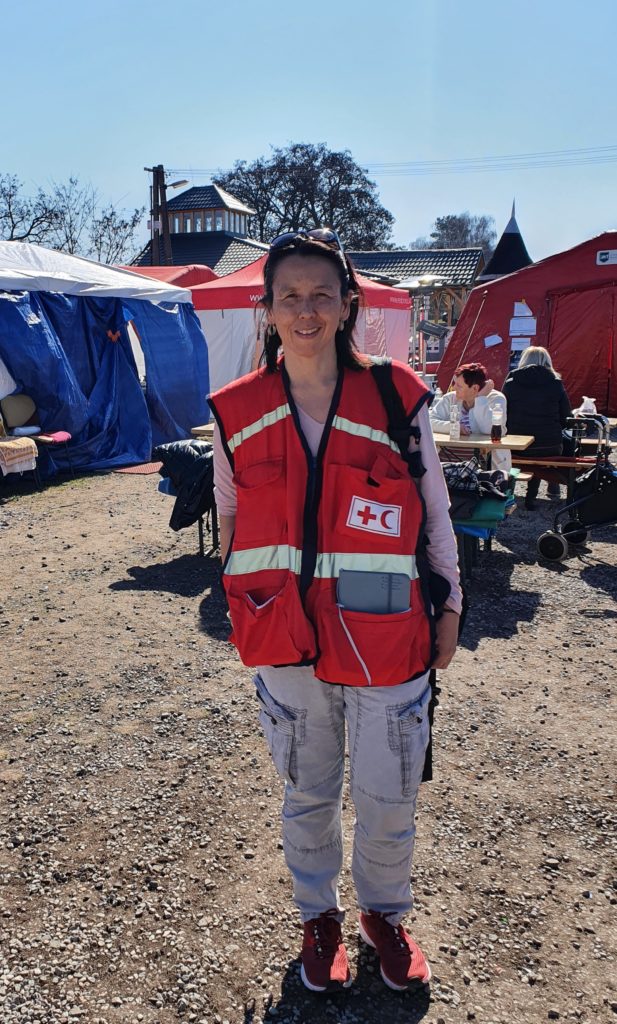Running a nation-wide Information Centre during an Emergency
When there is conflict in a country, emergency responses for the communities need to be put in place quickly. For actors in the field this can lead to new vocations. This has been the experience of Volodymyr Havryiluk and Andriy Maryniak who are running the Ukrainian Red Cross (URCS) Information Center in Lviv, Ukraine. Volodymyr, coordinator of the info center, has a degree in HR and private sector economy. Andriy, deputy coordinator and Vladimir’s right hand-man, studied history and is a teacher by training. When the conflict started all this changed and they stumbled on this new vocation at the URCS.
For Ukrainians in need for information or help, there is a number on the webpage, Facebook and Instagram of the URCS. On the other side of the call, in the background handling the processes, are Volodymyr and Andriy. With patience and understanding of the difficult situations of both the people calling in and the operators, they work tirelessly to make sure that everyone gets the information, humanitarian aid and help that they need.
A Nation-Wide Information Center
The information center is based in western Ukraine, Lviv. Lviv stands at the heart for people seeking shelter during the conflict. The information center is based in western Ukraine, Lviv. Lviv stands at the heart for people seeking shelter during the conflict. However, the night before the interview alarms were heard also here.
The center gets calls from everywhere in Ukraine. They then send the requests to the regional offices. “We try to provide only one phone number, one email address. It’s simpler, so that every part of Ukraine can call one number… It’s very hard to remember five phone numbers – one is easier.” – Andriy explains. People also hear about them through word-to-mouth. Volodymyr and Andriy talks about a time when a call came in from a small town in the eastern region. The regional branch provided them with help and suddenly calls came in from all the small towns in the region because word had spread that the URCS was working and helping.
Before the conflict, there was an existing small-scale information center, originally set-up during the COVID-19 pandemic. With the conflict, the requests increased and the need for help grew drastically. Volodymyr and Andriy assisted in expanding the center. They helped finding a place, rented an office and started working. The center, as it is today, was fully up-and-running on the 3rd of May.
The information center is now operated by 14 people, many of whom are themselves Internally Displaced Persons (IDP’s). They get up to 15-20 000 calls a week. This is a vast number of calls – do they work 24 hours a day? “No”, they respond. The center is open from 8 am to 7 pm. They monitor the peak times to have sufficient capacity then. For now, having night shifts and work during holidays is not a priority – on the contrary – they need to manage all the requests coming in during working hours. They can currently respond to approximately 30 – 50 % of the requests but are in the process of hiring more operators to be able to adequately handle all the calls.

Three departments, four lines
All the calls coming in are divided into three departments depending on the request. The first department is an “ordinary” information hotline, the second is for psychological support and the third one is to Restore Family Links (RFL). Calling the general number, you get directed to the appropriate department. A fourth line that handles the requests coming in through email, messenger, and the chat-bot is recently set up.
Today, most requests concern humanitarian aid – people who lost their homes, who lost everything, get in touch. Internally Displaced Persons (IDPs) ask for temporary shelter, food, and hygiene products. When they return, they may also ask for help to start rebuilding their homes – these requests now come mainly from the Kiev region as people are starting to return there.
Many requests for financial aid also come in– people ask for vouchers and financial support programs. Many have lost their jobs and their income due to the conflict and they need help to be able to support themselves.
They also get many requests to Restore Family Lines (RFL) – there are really many of them, they say. People have lost touch of friends and family during conflict.
Volodymyr and Andriy point out that armed conflict is especially difficult for people with disabilities and older populations and that they get a lot of requests for home care. Knowing how to help is best done through active community engagement.

Community Feedback
This information center, at the heart of the emergency response, is an important community engagement hub in Ukraine. Most operators are IDP’s themselves and have been through traumatizing experiences, which makes them well-placed to understand and respond to the requests of the caller. They handle the requests that come in primarily in Ukrainian but also in Russian. The important thing is that everyone feels comfortable with the language they use.
The center gets information about people’s needs in real time. They can then provide information directly back to those who needs it, but they also collect feedback, conduct analysis, and notify the needs to other branches such as the URCS, IFRC and the ICRC. Getting feedback from the community is immensely important, they say, even just to be able to give the right help to each person.
Right now, for instance, there is a big medical emergency in Ukraine. People need access to both medical services and medicines. It’s difficult to get hold of, for example, high-value cancer medicines. Volodymyr and Andriy puts this into their reports so that other organizations can pick it up and hopefully provide help.
Focus on mental health and feedback sessions
Working in such high-pressure environment demands a lot of feedback sessions. There is a weekly meeting where everyone can bring their questions and they are discussed and processed together. At the beginning of each workday, Volodymyr and Andriy do a 15-minute information session to make sure the operators are up to date before the start of the day.
The center also provides mental health help. If the operator receives a very difficult call there is always a possibility to take some time off, have a break, go for a walk, or just think about it. This is important. They also have operators with a diploma in psychology who can help and give professional support in a critical situation.
This article was written by IFRC’s Minna Guigon-Sell (CEA Communications Consultant)

The escalation of armed conflict in Ukraine on the 24 February 2022 led to a large humanitarian crisis which overflowed to neighbouring countries. Many people had to leave their homes and go to shelters and reception centres in search for safety. Community Engagement and Accountability Surge Officers went to help people fleeing their homes in this distressing situation.
Miki Tsukamoto worked as CEA Surge Officer in Slovakia during the first rotation of the emergency. As she was there, she visited the border areas and went to the reception centers to observe how people entered the country. She wanted to give them an opportunity to tell their own stories and made two participatory videos at the end of her stay. She tells us about the process, the challenges and what she learned. Especially how important it is to make sure that the person you talk to is okay with being interviewed and that you adopt a strict “do no harm” approach.

Participatory videos let you own your story
Participatory videos are films where the participants play an active role in the creation process. Miki stresses that to empower and raise a person’s voice, it is important to include them in designing, filming and editing their own videos. This ensures that the story is really owned by them. Different from a report, participatory videos also provide footage and live accounts which at times tend to capture audiences more than a static, written report. Participatory videos can also help the participant to process their own experiences and share them in an immediate way.
The ”Do No Harm” approach
But how do you approach a person in such a distressing and stressful situation? When Miki first visited a reception centre, she felt that she didn’t have the right to approach people crossing the boarders. She says that for anyone visiting the border points, it was evident that some of the people were traumatized and still trying to figure out where they would go and what they would do after fleeing their homes in Ukraine. When conducting this kind of participatory initiative, timing is key. This is why she only decided to carry out the project after having frequently visited and observed the three border areas and reception centres. At the time when she carried out the two participatory video initiatives it was close to the beginning of April, and displaced persons were staying longer at the reception centre.
Another important element is to ensure a “Do No Harm” approach. This means making sure not to approach anyone whose trauma risks being intensified through the process, or to exacerbate stress-levels. Participating in a video should be helpful and bring something to the participant. This means making sure that they want to do it; making sure of consent.
At both the reception centre and the temporary shelter making sure of consent involves carefully observing potential candidates before approaching them. For example, at the temporary shelter individuals and families are staying for differing amounts of time – they live in tents spread across the location. Many of these persons have been through a long wait at the border or have conducted a long journey, and that’s why it is important not to make the situation more exhausting. It is also important not to carry out the initiative right before departure.
Once someone had been identified, the small team of two people – Miki herself and her translator – approached them and thoroughly explained the participatory video initiative and, if they agreed to do the video, ask them to sign a written consent form in their local language. Only after this could the filming begin.
A small team of two with the help of National Society
It’s not easy to get in touch with people in distressing situations. Miki explains that it is important to make people feel at ease and to approach them in the language which is most comfortable for them. Therefore, she had the good fortune to be accompanied by an excellent Slovak Red Cross volunteer who spoke Ukrainian and Russian. She was also an excellent communicator when discussing with the displaced women. Support from the National Society (at the Headquarters and Branch level) was also essential; they provided the background information and contacts needed to approach people at the reception centres.
Location: A reception center at the beginning of an emergency
Miki has carried out many participatory video processes in various locations in the past. But she says that it was in many ways a different experience this time.
In general, she has always kept a strict community-based approach. This means entering the community first, spending time and working with the representative groups, and only then – with a strong understanding of the community- carry out the filming. But as it was the first month of an emergency operation, and the fact that the people were passing by on their way to somewhere else, it was not possible this time.
Registration centres are busy locations and in view of the conflict, the long journey and at times separation from family(ies), emotions and stress levels could be high. It was important to be aware of this when deciding on the appropriate time to carry out the activity. Having someone who could speak the local languages as an interpreter was also essential in helping putting people at ease.
Key take–aways
Miki’s key take aways from this experience are the importance to be flexible and ready to adapt to the evolving emergency context. Prioritize your activities and time them, so you can have a meaningful impact and respect a “Do No Harm” approach.
And most importantly: Listen and Learn!
This article was written by IFRC’s Miki Tsukamoto (CEA Surge Officer) and Minna Guigon-Sell (CEA Communications Consultant)
Discover participatory video resources, including templates and videos, here.
